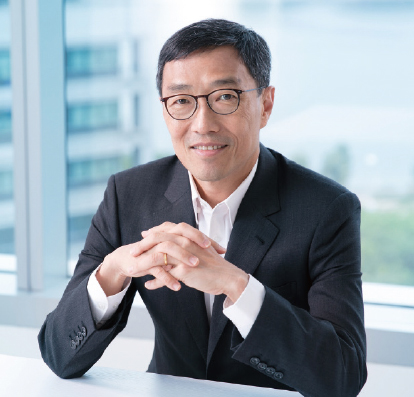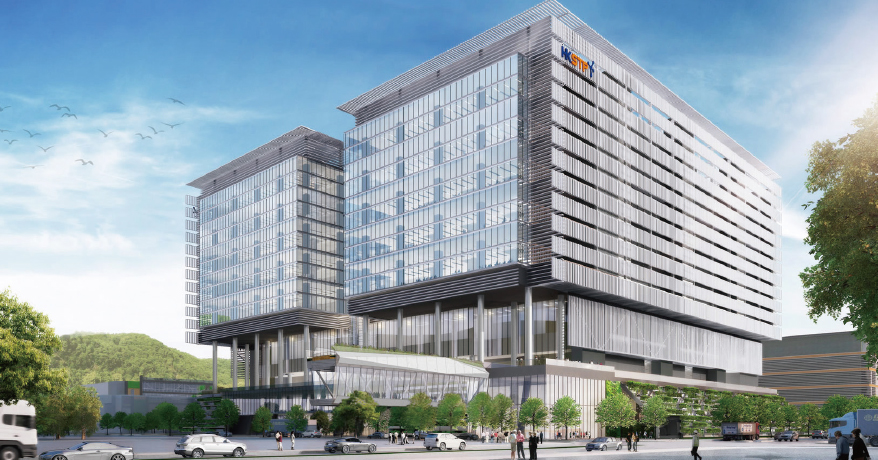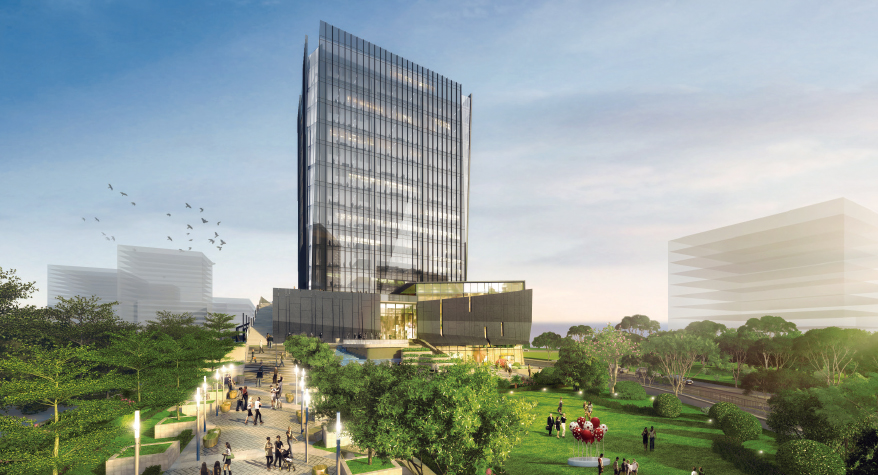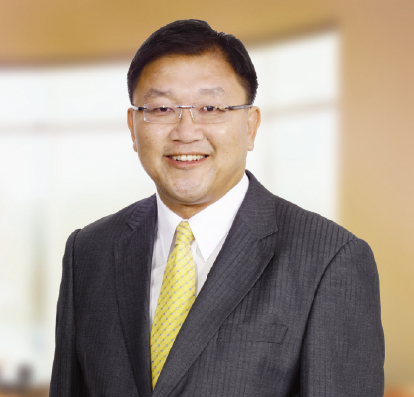In view of the significant contribution of Hong Kong’s industries to GDP and employment, the Budget this year has proposed to allocate HKD2 billion to launch the “Reindustrialization Funding Scheme” to drive the development of advanced manufacturing by tapping into innovation and technology (I&T) solutions, thus bringing about a magnificent transformation for Hong Kong’s industries.

Albert Wong: Redefining Hong Kong “Industry”
 As part of its efforts to support reindustrialization in recent years, the HKSAR Government has set aside HKD2 billion for Hong Kong Science and Technology Parks Corporation (HKSTPC) to convert a factory building in Yuen Long Industrial Estate into a Microelectronics Centre. Albert Wong, Chief Executive Officer of HKSTPC, said that HKSTPC always supports the upgrading and transformation of its industrial estates to attract outstanding manufacturers to establish their presence here and keeps pace with Hong Kong’s reindustrialization.
As part of its efforts to support reindustrialization in recent years, the HKSAR Government has set aside HKD2 billion for Hong Kong Science and Technology Parks Corporation (HKSTPC) to convert a factory building in Yuen Long Industrial Estate into a Microelectronics Centre. Albert Wong, Chief Executive Officer of HKSTPC, said that HKSTPC always supports the upgrading and transformation of its industrial estates to attract outstanding manufacturers to establish their presence here and keeps pace with Hong Kong’s reindustrialization.
“We need to redefine the word ‘industry’ as society continues to progress.” Wong believes that technology applications are the major trend in today’s new era. Hence, the meaning of “industry” should include emerging industries, supporting reindustrialization through multifaceted use of advanced manufacturing.
Three industrial estates covering different industries
HKSTPC currently manages three industrial estates in Tai Po, Yuen Long and Tseung Kwan O. As of the end of March 2020, the industrial estates had an overall occupancy rate of about 90% and housed about 130 companies involving over 150 manufacturers and employing about 28,000 people.
According to Wong, the industries operating in the industrial estates are mainly food and beverages, biotechnology and pharmaceuticals, support services, and information and telecommunications. “Those in the Tai Po and Yuen Long industrial estates are mainly traditional ones, while those in the Tseung Kwan O industrial estate are more advanced.”
Seven directions for selecting partners
 To achieve the goal of reindustrialization, the HKSAR Government and HKSTPC revised the industrial estate policies in 2015 to support the development of high-value-added and hi-tech industries. “Focusing on upgrading and transformation, the industrial estates build high-efficiency multi-storey industrial buildings for rental to I&T industrial partners.” Wong stressed that the Advanced Manufacturing Centre (AMC) provides companies with adaptable and low-cost production facilities to produce technologically innovative, high value-added, low-volume and highly customised products.
To achieve the goal of reindustrialization, the HKSAR Government and HKSTPC revised the industrial estate policies in 2015 to support the development of high-value-added and hi-tech industries. “Focusing on upgrading and transformation, the industrial estates build high-efficiency multi-storey industrial buildings for rental to I&T industrial partners.” Wong stressed that the Advanced Manufacturing Centre (AMC) provides companies with adaptable and low-cost production facilities to produce technologically innovative, high value-added, low-volume and highly customised products.
Wong added that today’s reindustrialization emphasises advanced products, advanced production methods and hi-tech talents. Looking ahead, HKSTPC will use a different set of criteria for selecting partners, mainly in seven directions: production of hi-tech products, addition of advanced manufacturing processes, production to meet Hong Kong’s needs, combination of I&T R&D elements, increase of high-quality employment opportunities, promotion of Hong Kong’s industrial products, and active investment in Hong Kong manufacturing.
Microelectronics Centre aims to revive electronics sector
To step up support, the Finance Committee of the Legislative Council has just approved setting aside HKD2 billion for HKSTPC to convert a factory building in Yuen Long Industrial Estate into a “Microelectronics Center” equipped with the necessary facilities to produce microelectronics, allure and retain the talents in the industry, and provide supporting facilities such as shared laboratories and offices.


Wong said that building Microelectronics Center in Hong Kong is very important for the development of the entire electronics sector. “We have received a lot of views indicating that manufacturers are interested in shifting production demand to Hong Kong, especially the microelectronics industry, and many people still want to stay in Hong Kong for front-end R&D.” In Wong’s view, the strengths of Hong Kong’s electronics sector coupled with the fact that many local universities offer courses in relevant disciplines should enable the creation of a good industrial ecology in which talents can maximise their strengths, thereby driving the process of reindustrialization.

Wong Kam-fai: Full-speed “Reindustrialization” via Combination of Greater Bay Area’s Strengths
With the development of innovation and technology (I&T) industries now a major trend globally, Wong Kam-fai, Associate Dean (External Affairs) of the Faculty of Engineering at the Chinese University of Hong Kong, is convinced that Hong Kong’s orientation towards “reindustrialization” for development is indeed correct, but it should shift focus to the Guangdong-Hong Kong-Macao Greater Bay Area (Greater Bay Area) market for complementarity of strengths.
Wong said that many people have misunderstood the definition of “reindustrialization” as merely encouraging Hong Kong businesses to move their factories and production lines back to Hong Kong, “‘Reindustrialization’ is a process during which public resources are redistributed in response to changes in public conditions and resources as well as political and economic conditions for repositioning of industrial development.”
“In recent years, the Government has adopted a multi-pronged approach by rolling out different measures for “reindustrialization” and setting up the HKSAR Committee on Innovation, Technology and Reindustrialization.” However, Wong admitted that the measures are still unable to stick closely to the core direction of developing I&T industries, making the “reindustrialization” orientation seem unclear to many people.
Complementarity of strengths with Greater Bay Area cities
 Wong stressed that the Government and business community should look beyond Hong Kong and consider how to integrate with the Greater Bay Area during “reindustrialization”. “The demand chain has gradually replaced the supply chain model in the digital age. The demand chain is where the buyer orders from the manufacturer only when there is a need, and the manufacturer provides the buyer with personalized services. The business community can meet customer needs by partnering with companies proficient in different fields in the Greater Bay Area.”
Wong stressed that the Government and business community should look beyond Hong Kong and consider how to integrate with the Greater Bay Area during “reindustrialization”. “The demand chain has gradually replaced the supply chain model in the digital age. The demand chain is where the buyer orders from the manufacturer only when there is a need, and the manufacturer provides the buyer with personalized services. The business community can meet customer needs by partnering with companies proficient in different fields in the Greater Bay Area.”
Wong further explained that as the demand chain aims to meet market or customer needs, it is often necessary to bring in I&T, e.g. to design suitable products for customers by using technologies such as big data and Internet of Things (IOT) to analyze their preferences and requirements. “The Hong Kong business community can partner with companies of advantages in the Greater Bay Area, not only to speed up production but also to help reduce costs.”
Enhance information exchange for accurate resource allocation
To leverage the advantages of the Greater Bay Area, Wong believes that first and foremost, the “9 +2” cities must reach information exchange agreements to consolidate information from each site in the area and conduct data analysis in Hong Kong for accurate resource allocation.
“These sites can be widely distributed in different cities in the Greater Bay Area, maximizing the strengths of each city. Intellectual property and basic scientific research can be conducted in Hong Kong and then convert the relevant technologies into products through the Science Park or Cyberport and consider using the huge market of the Greater Bay Area as a pilot.” He added that if the R&D results are successful in the Greater Bay Area, the next step will be to extend to the nationwide and “Belt and Road” (B&R) markets.
Promote conversion of R&D results
For the short- and medium-term objectives of “reindustrialization”, Wong said that the Innovation and Technology Bureau has formulated a series of policies for the development of relevant industries. The direction of development is correct, and a lot of resources have been invested. However, the public and the business community are still doubtful about their effectiveness. “In the short to medium term, the Government should concentrate on assisting in the successful implementation of some promising local independent R&D and production projects, which can also attract more funding for I&T development. Coupled with leveraging the advantages of the Greater Bay Area, they can focus on the Mainland and B&R markets over the next five to ten years with a view to bringing greater benefits for promoting ‘reindustrialization’.”




